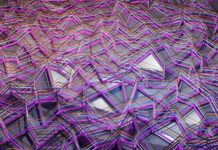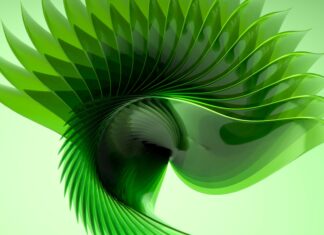Generative art, a captivating and ever-evolving field, lies at the intersection of art and technology, harnessing the power of algorithms to create unique and dynamic visual compositions. It is an artistic practice that places emphasis on the process of creation rather than the final outcome. By employing code, mathematical equations, and computational systems, generative artists unleash a realm of possibilities, where art is not merely crafted by human hands but collaborates with machines to produce novel and unexpected results.
Generative art embraces the notion that creativity can emerge from the marriage of human imagination and computational processes. It represents a departure from traditional forms of art, where the artist’s vision is singularly executed, by embracing chance, randomness, and the autonomous decisions of algorithms. The generative artist becomes both a creator and a curator, designing systems that generate art autonomously or in collaboration with human intervention.
The core concept underlying generative art lies in the creation of rules or algorithms that define the behavior of an artwork’s elements. These rules can range from simple mathematical equations to complex computational algorithms. As the artist defines these rules, they introduce a level of indeterminacy, allowing for the emergence of various outcomes within a set of defined parameters. The generative art process becomes an exploration of these parameters, tweaking and experimenting until the desired aesthetic result is achieved.
Generative art finds its roots in early experiments with algorithmic processes, which date back to the mid-20th century. Pioneers such as Vera Molnar, Georg Nees, and Frieder Nake, among others, sought to utilize the emerging capabilities of computers to create art. Their works often consisted of geometric patterns and intricate structures generated through mathematical formulas and algorithms. These early explorations paved the way for subsequent generations of artists to delve deeper into the possibilities of generative art.
The advent of personal computers in the late 20th century brought generative art into the mainstream. Artists now had access to tools and software that facilitated the creation and manipulation of complex algorithms. The emergence of programming languages like Processing, openFrameworks, and Max/MSP provided platforms for artists to experiment with code-driven creativity. These tools, combined with the proliferation of digital art and the internet, propelled generative art into a new era of exploration and innovation.
Generative art encompasses a wide range of techniques and styles. Some artists utilize procedural generation, where algorithms dictate the generation of each element of an artwork, resulting in intricate patterns, organic forms, or evolving compositions. Others employ evolutionary algorithms, simulating the processes of mutation, selection, and reproduction found in nature to create artworks that evolve and adapt over time. Additionally, machine learning and artificial intelligence have opened up new avenues for generative artists, enabling them to train models to generate art based on large datasets or interact with human input.
One of the defining features of generative art is its ability to produce infinite variations of an artwork. By leveraging the computational nature of algorithms, artists can create systems that generate unique compositions every time they are executed. This aspect challenges the traditional notion of the singular art object, as generative art blurs the boundaries between the original and the copy. Each instantiation of a generative artwork becomes a unique manifestation of the underlying rules and parameters, and the concept of an “original” takes on a new meaning.
Generative art has found its place in a variety of contexts, from galleries and museums to interactive installations, digital platforms, and virtual reality environments. It has become a medium for self-expression, social commentary, and exploration of aesthetic possibilities. Generative artists often engage with the concepts of emergence, complexity, and interactivity, inviting viewers to participate in the unfolding of the artwork or experience the dynamic nature of the generative process itself.
The impact of generative art extends beyond the realm of visual aesthetics. It has also influenced other disciplines, such as music composition and design. Generative music explores the application of algorithmic processes to create soundscapes that evolve and adapt over time. Artists like Brian Eno and Karlheinz Stockhausen have embraced generative approaches to composition, resulting in compositions that constantly transform and surprise the listener. In the field of design, generative principles have been employed to create innovative patterns, structures, and forms, challenging traditional design methodologies and pushing the boundaries of what is considered aesthetically pleasing.
Generative art not only pushes the boundaries of artistic expression but also raises philosophical questions about authorship, intentionality, and the role of the artist. With the artist becoming more of a facilitator or designer of generative systems, the notion of the artist as the sole creator of an artwork becomes blurred. Instead, the artist collaborates with algorithms, relinquishing some control over the final outcome and allowing for unexpected and serendipitous results. This shift challenges traditional notions of artistic genius and raises discussions about the role of intentionality in art creation.
Generative art also has connections to broader scientific and technological advancements. It draws inspiration from complex systems found in nature, such as fractals, cellular automata, and biological processes. By simulating and emulating these natural phenomena, generative art provides a platform for exploring the intricacies of the natural world and our place within it. Furthermore, the development of generative algorithms and computational techniques has practical applications in fields such as data visualization, simulations, and optimization processes.
As generative art continues to evolve, it intertwines with emerging technologies and new forms of creative expression. Virtual reality (VR) and augmented reality (AR) present exciting possibilities for immersive generative art experiences, where viewers can engage with dynamic and interactive artworks in three-dimensional spaces. Blockchain technology has also made its mark in the generative art world, enabling the creation of unique and provably scarce digital art pieces through non-fungible tokens (NFTs), revolutionizing the way art is bought, sold, and collected.
The democratization of generative art has been facilitated by the accessibility of tools and resources for aspiring artists and enthusiasts. Open-source frameworks, online communities, and tutorials have lowered the barrier to entry, allowing individuals with diverse backgrounds and skill levels to engage in generative art creation. This inclusivity has fostered a vibrant and diverse community of generative artists, collaborating, sharing knowledge, and pushing the boundaries of the field.
In conclusion, generative art represents a fusion of human creativity and computational processes, challenging traditional notions of art creation and opening up new avenues of exploration. It embraces the power of algorithms to generate unique and ever-changing visual, auditory, and interactive experiences. From its early origins in mathematical experiments to its current manifestations in virtual reality and blockchain technology, generative art continues to captivate artists, technologists, and audiences alike. It pushes the boundaries of creativity, blurring the lines between art, science, and technology, and inviting us to rethink our understanding of artistic expression in the digital age.





























